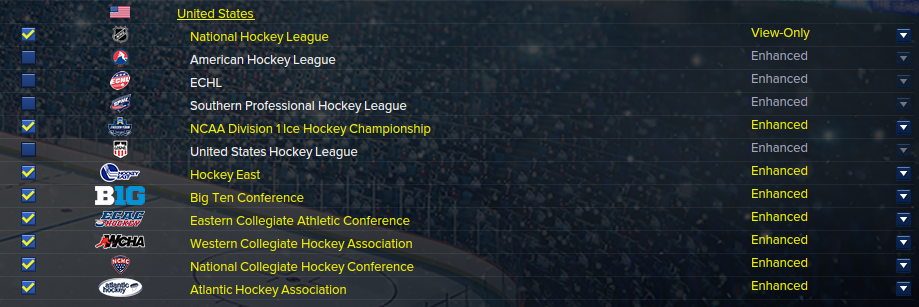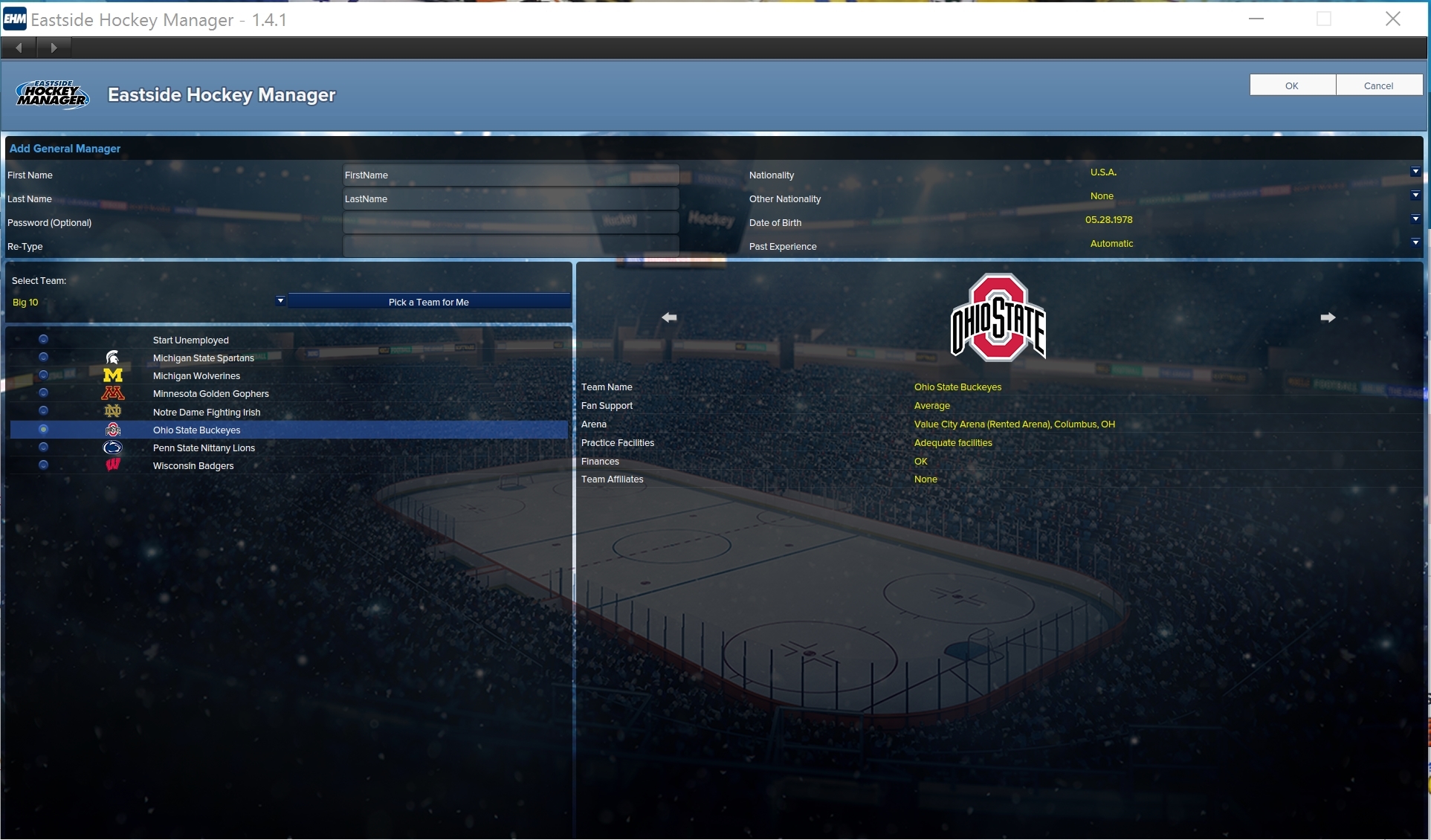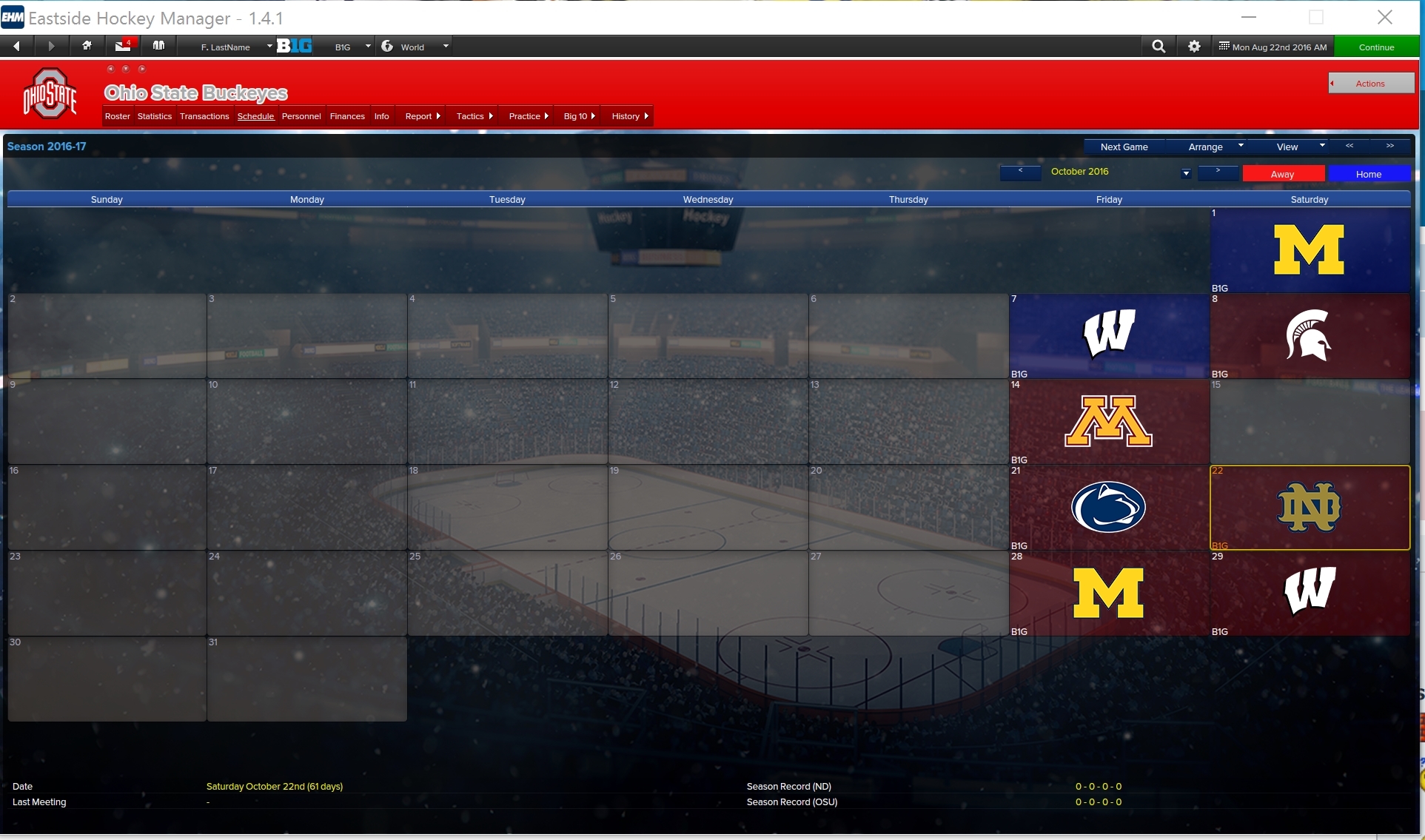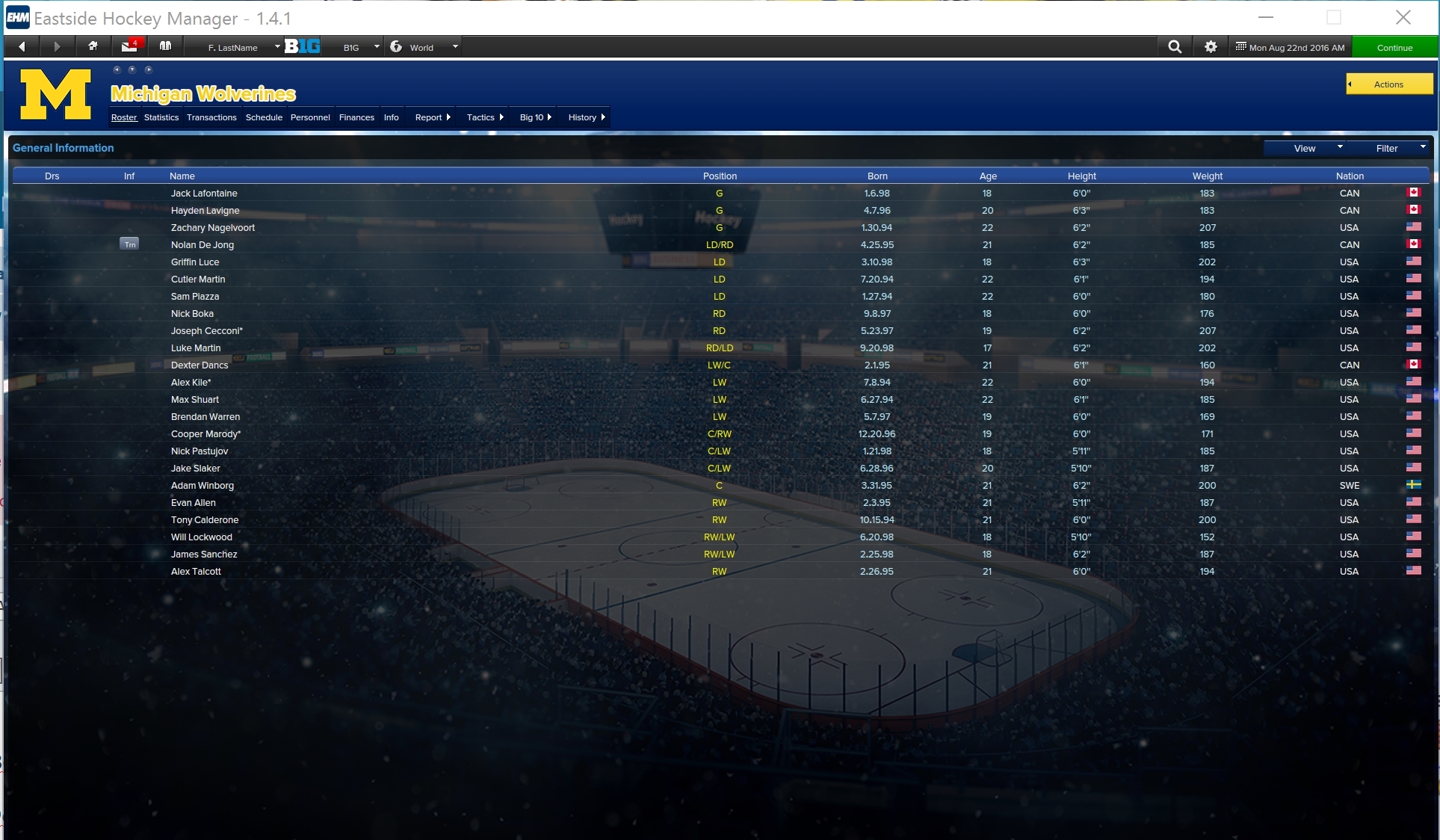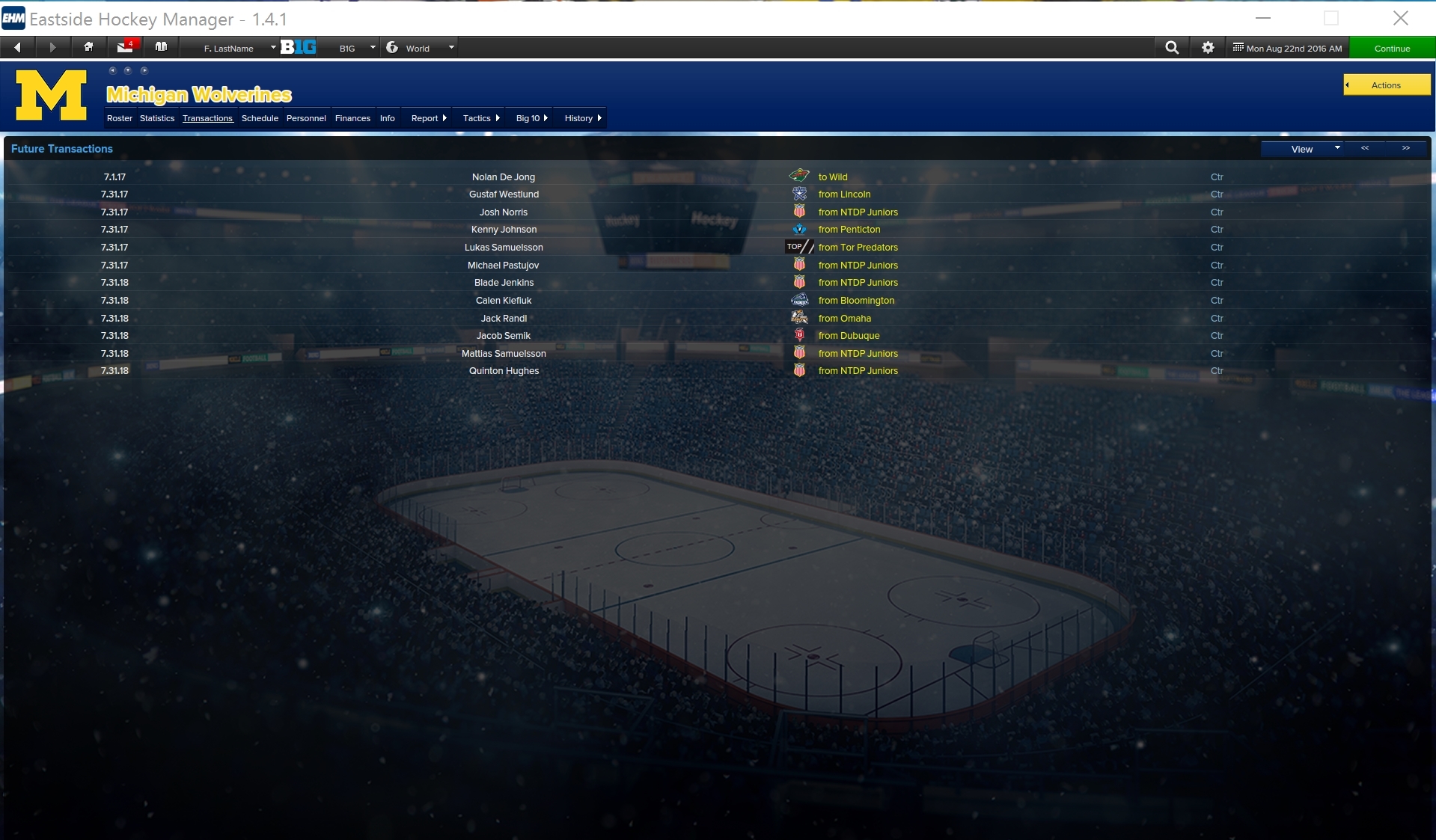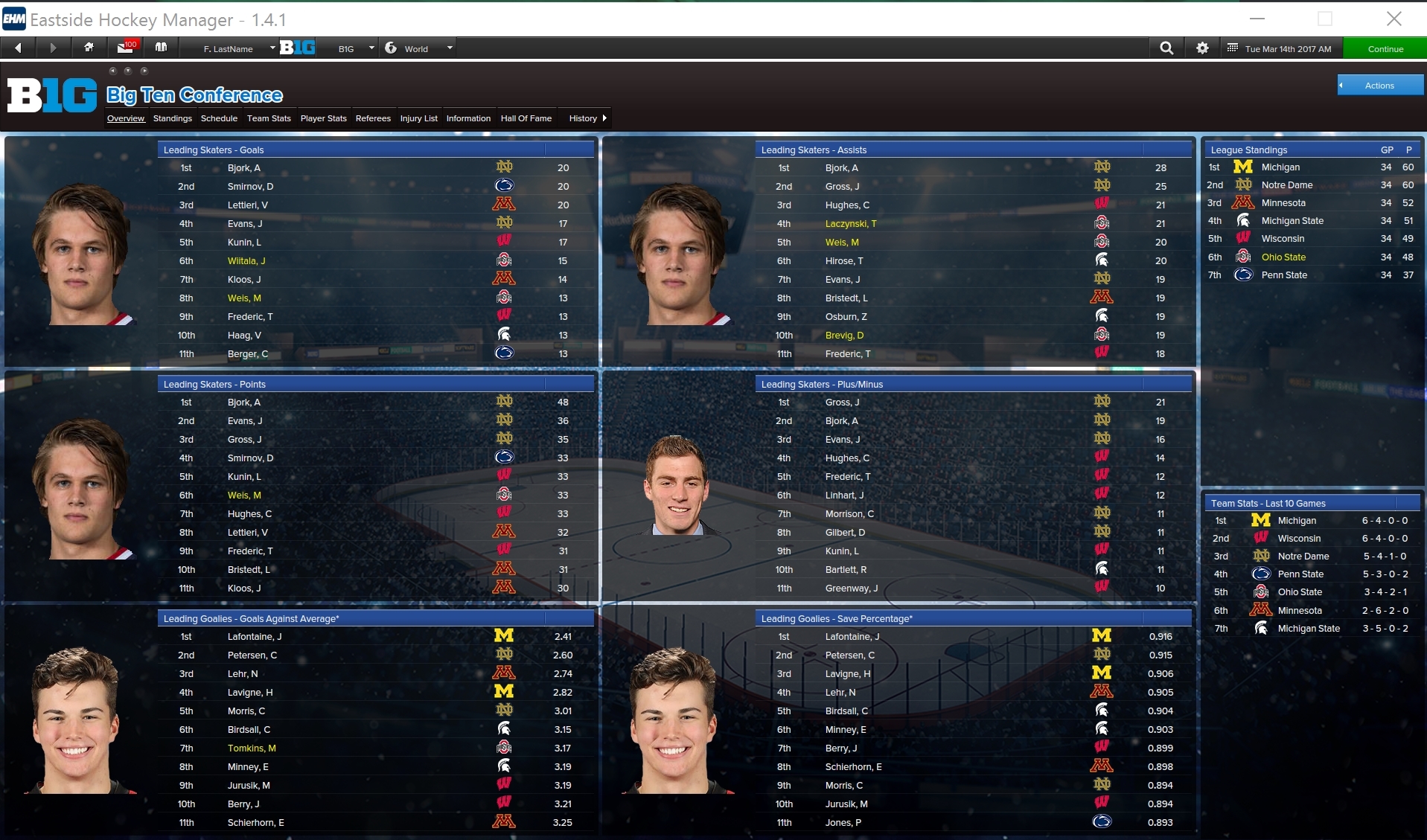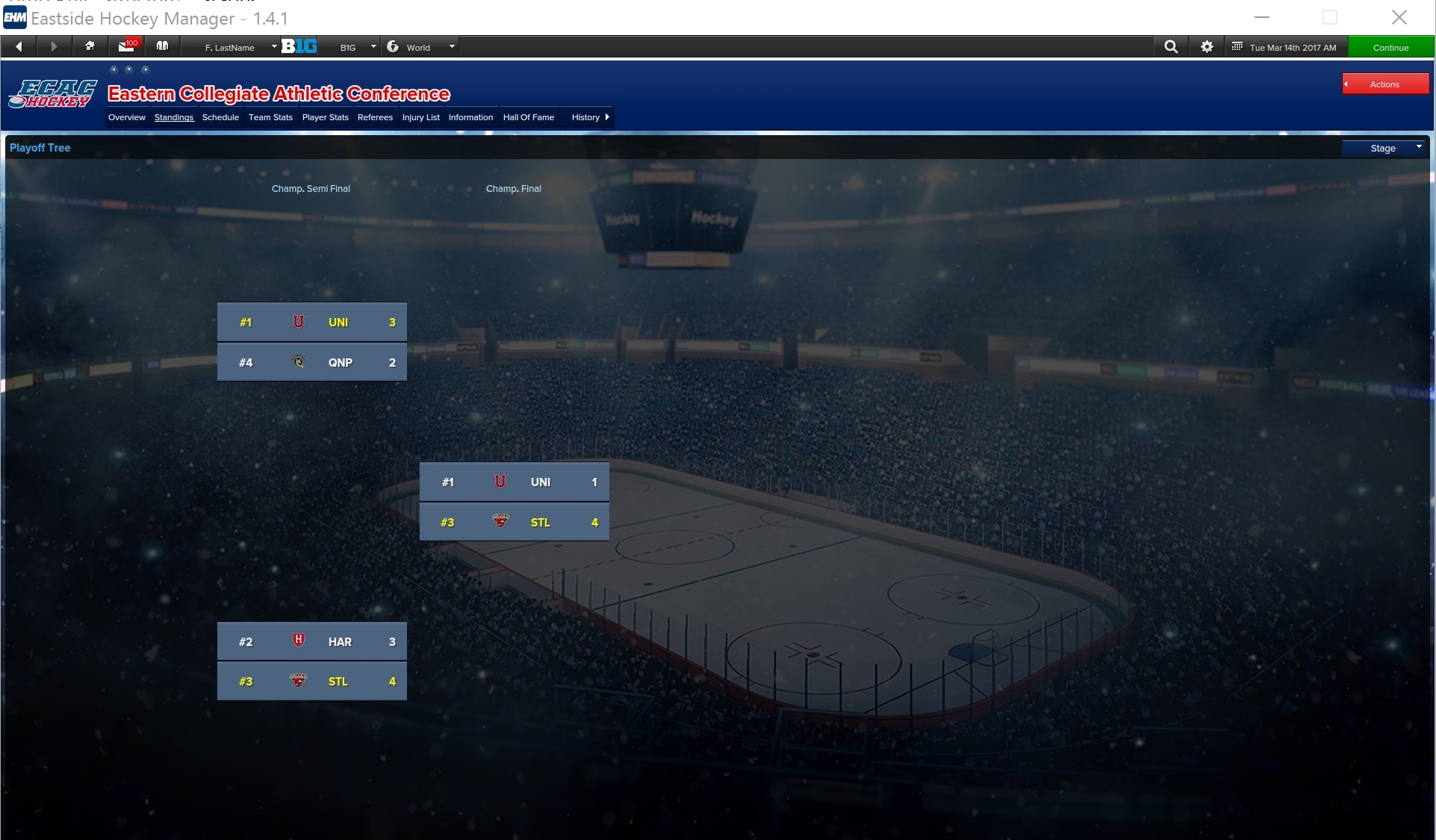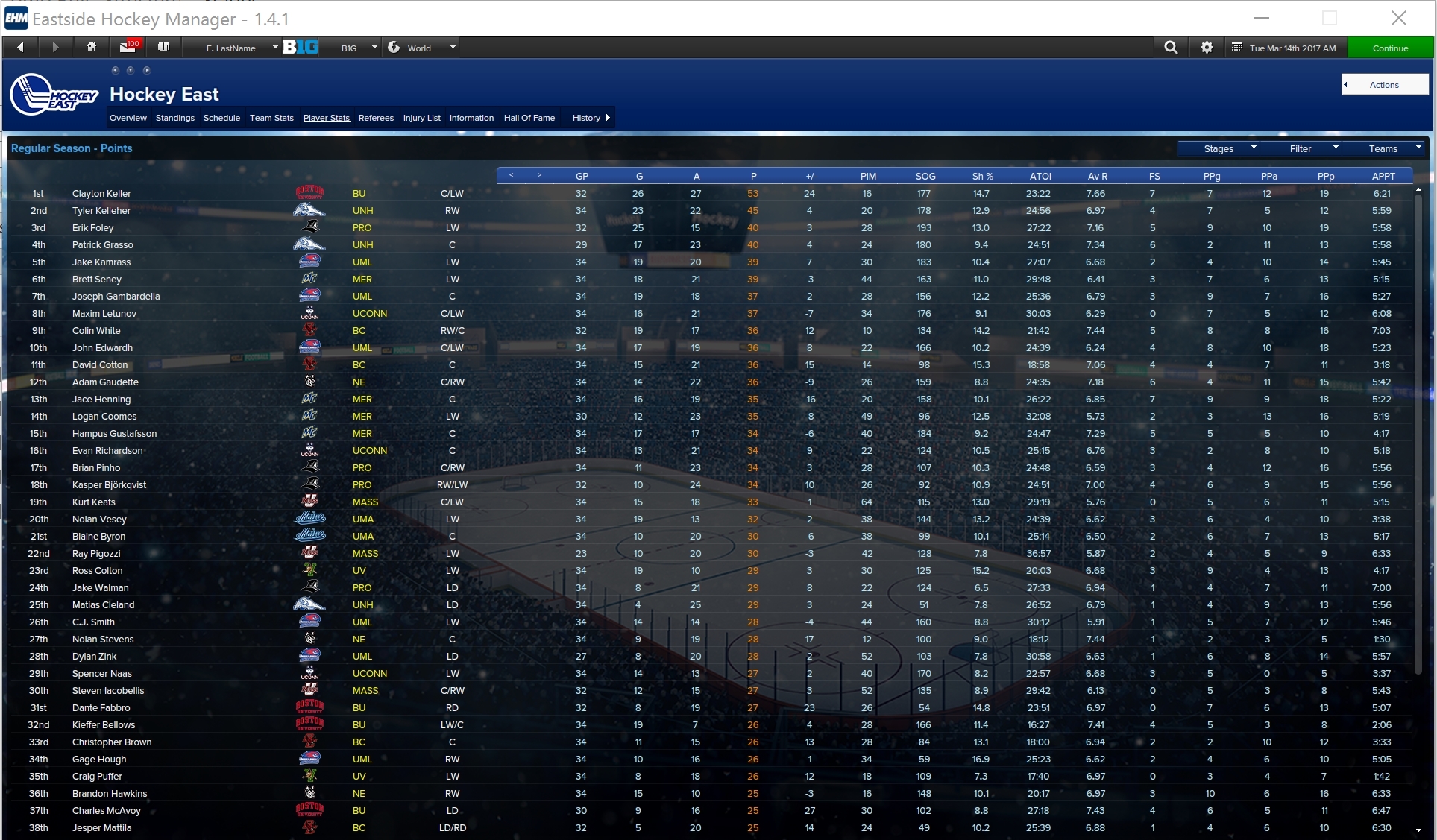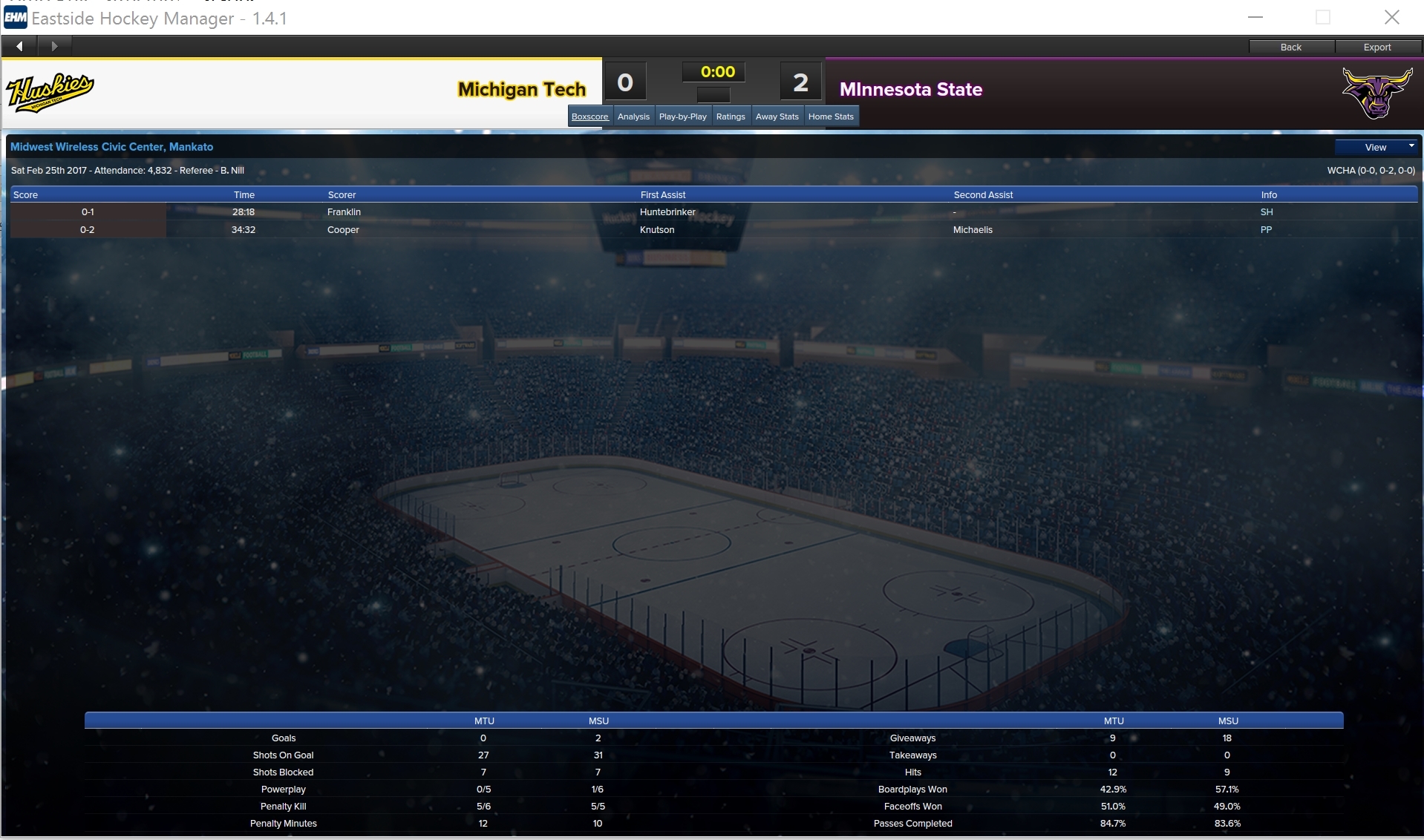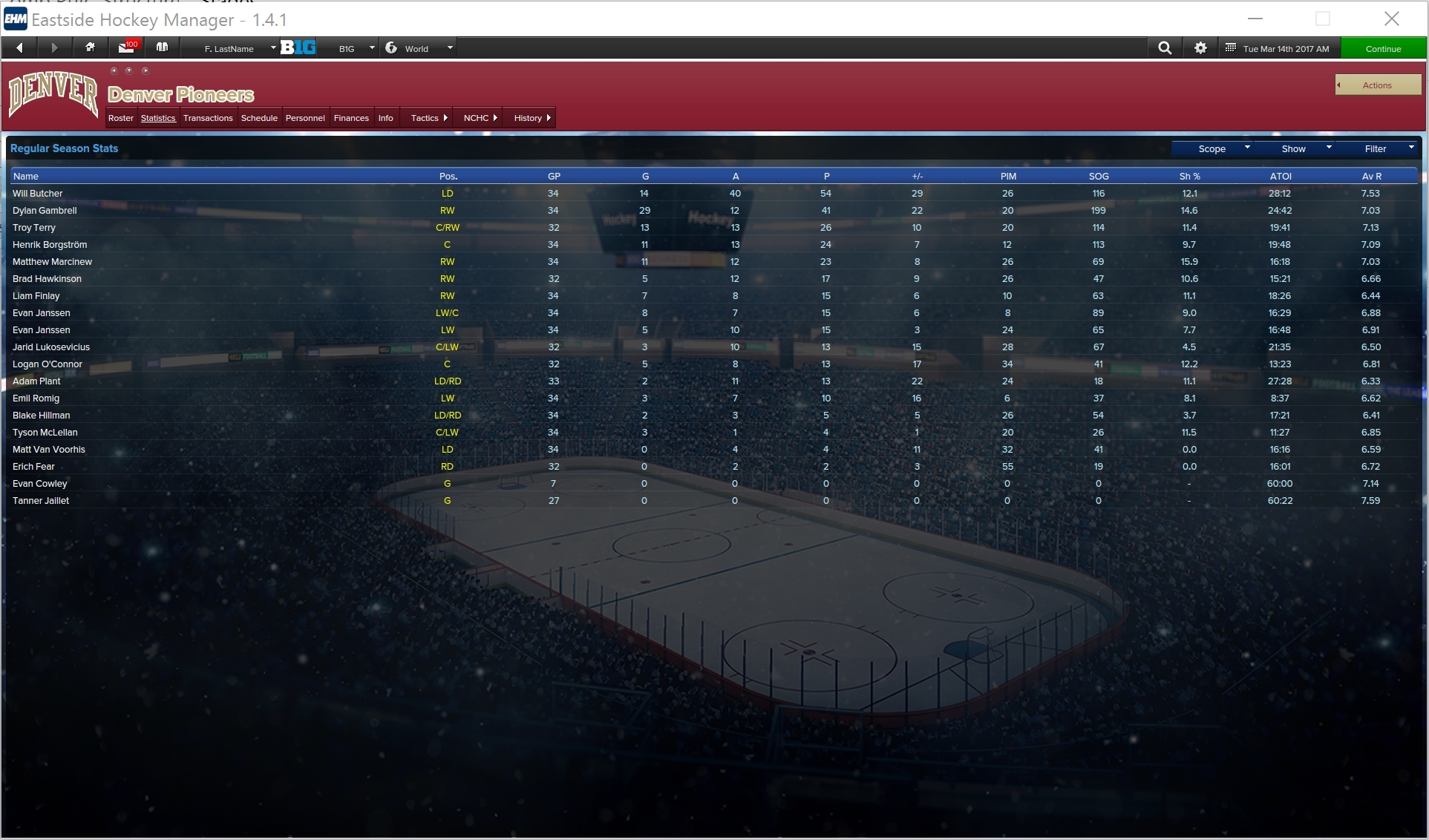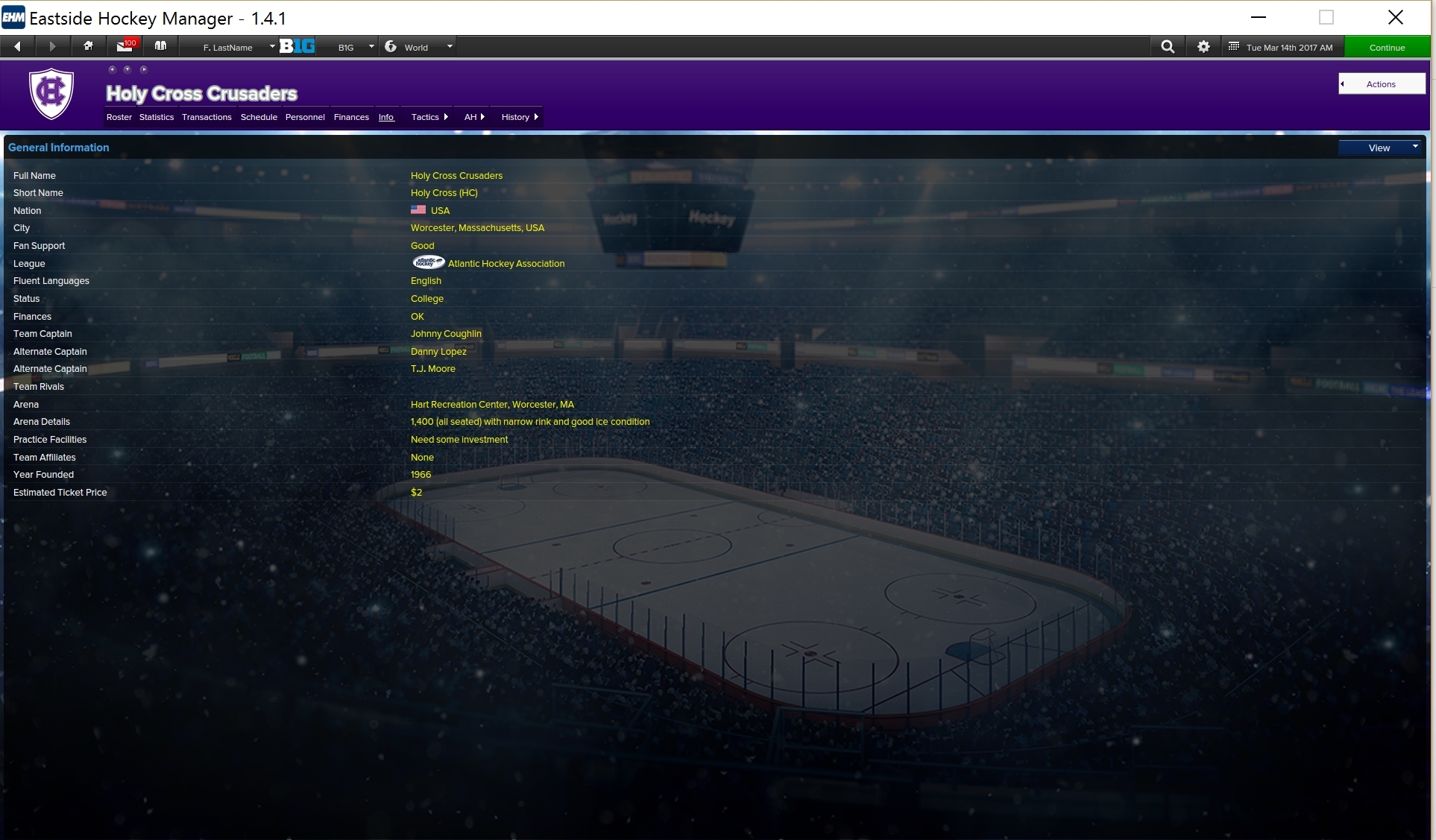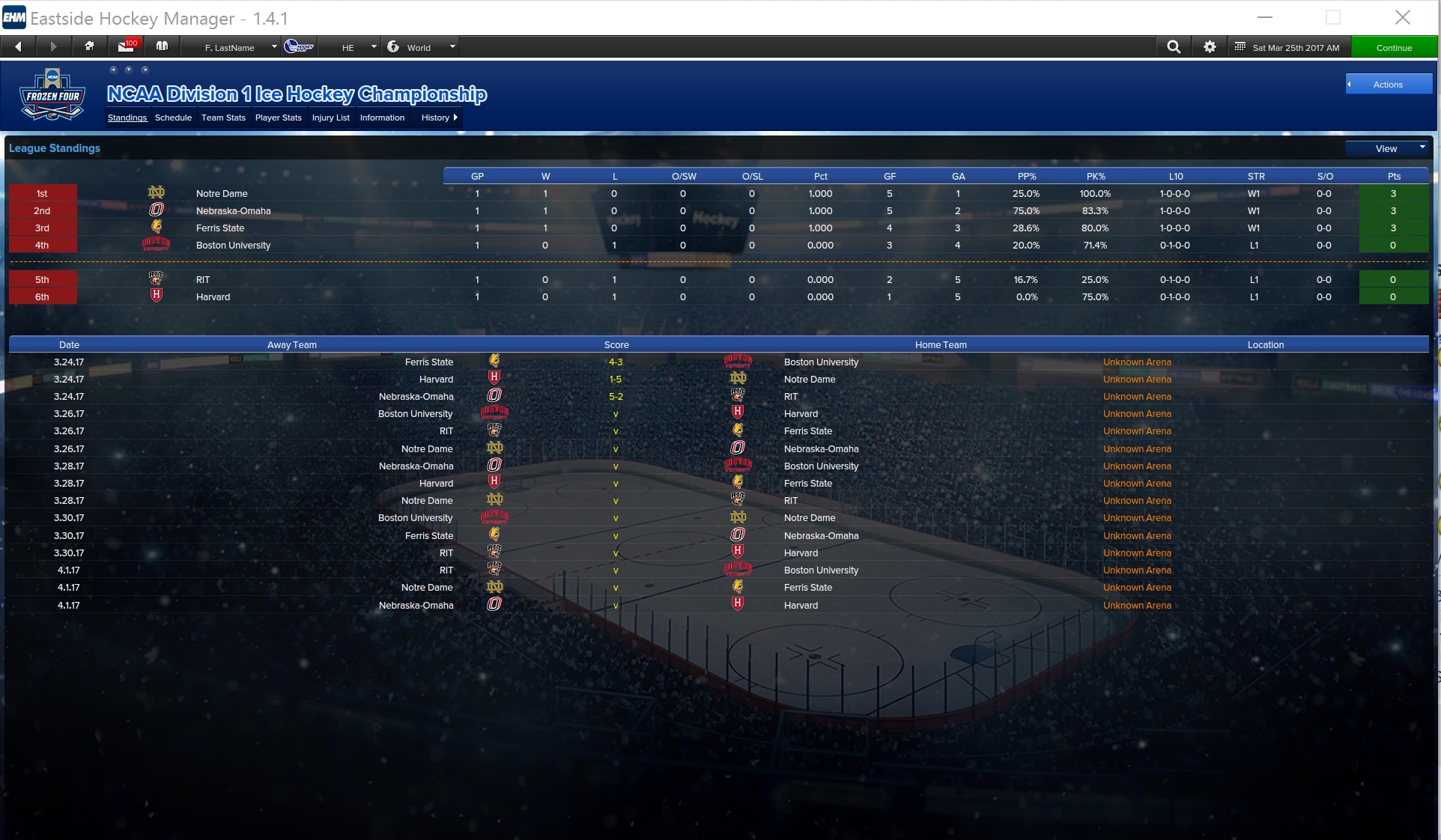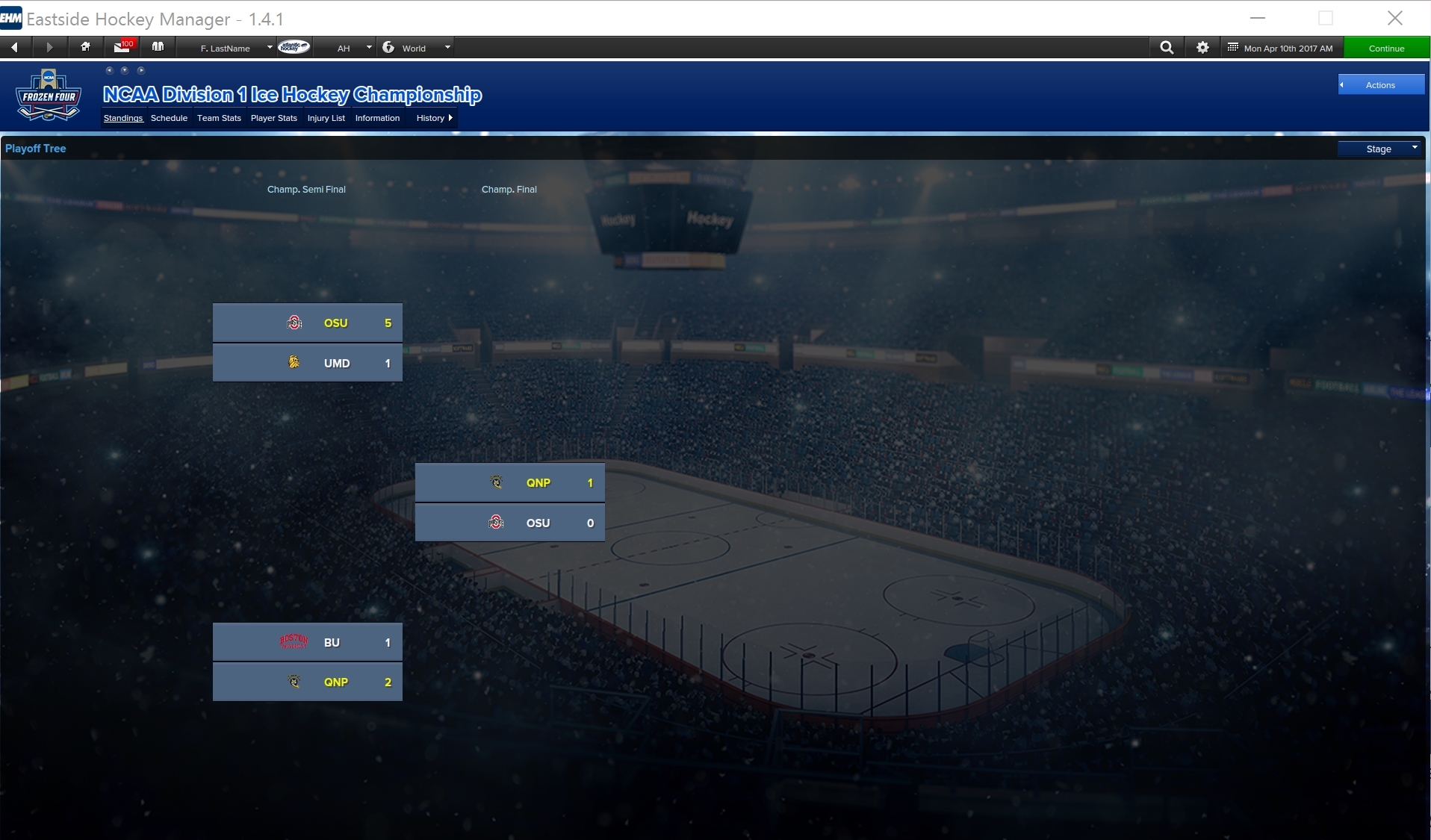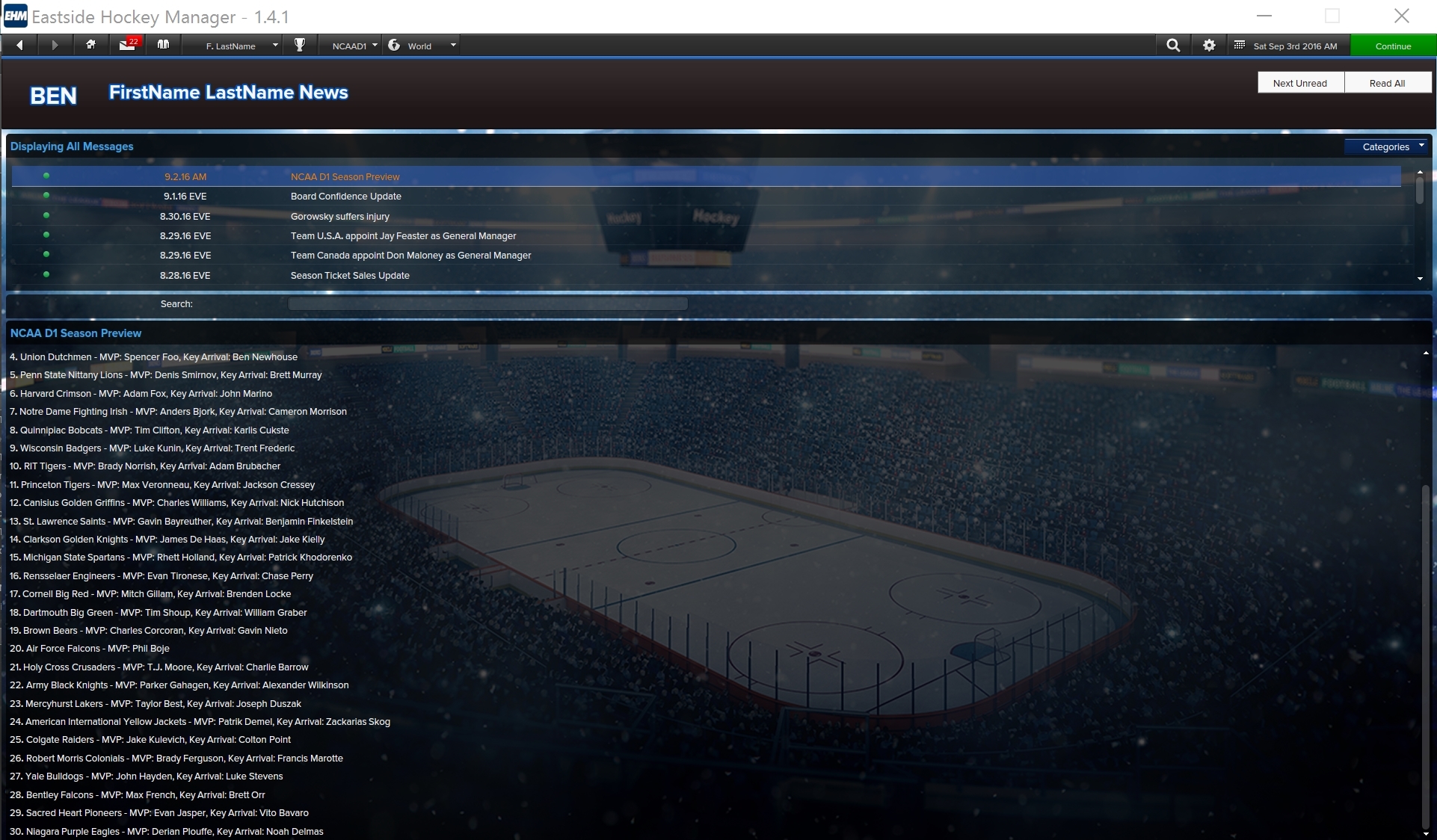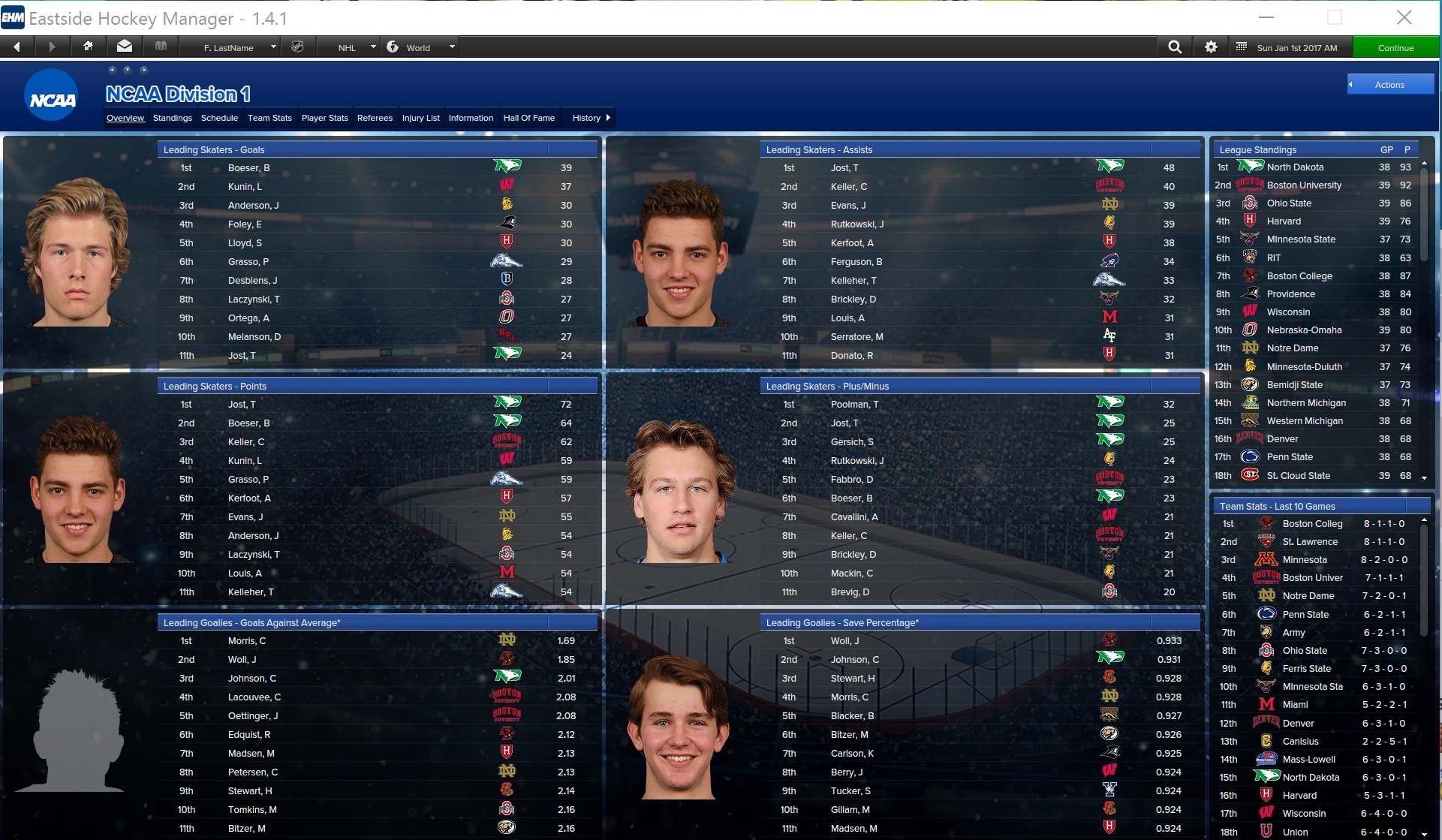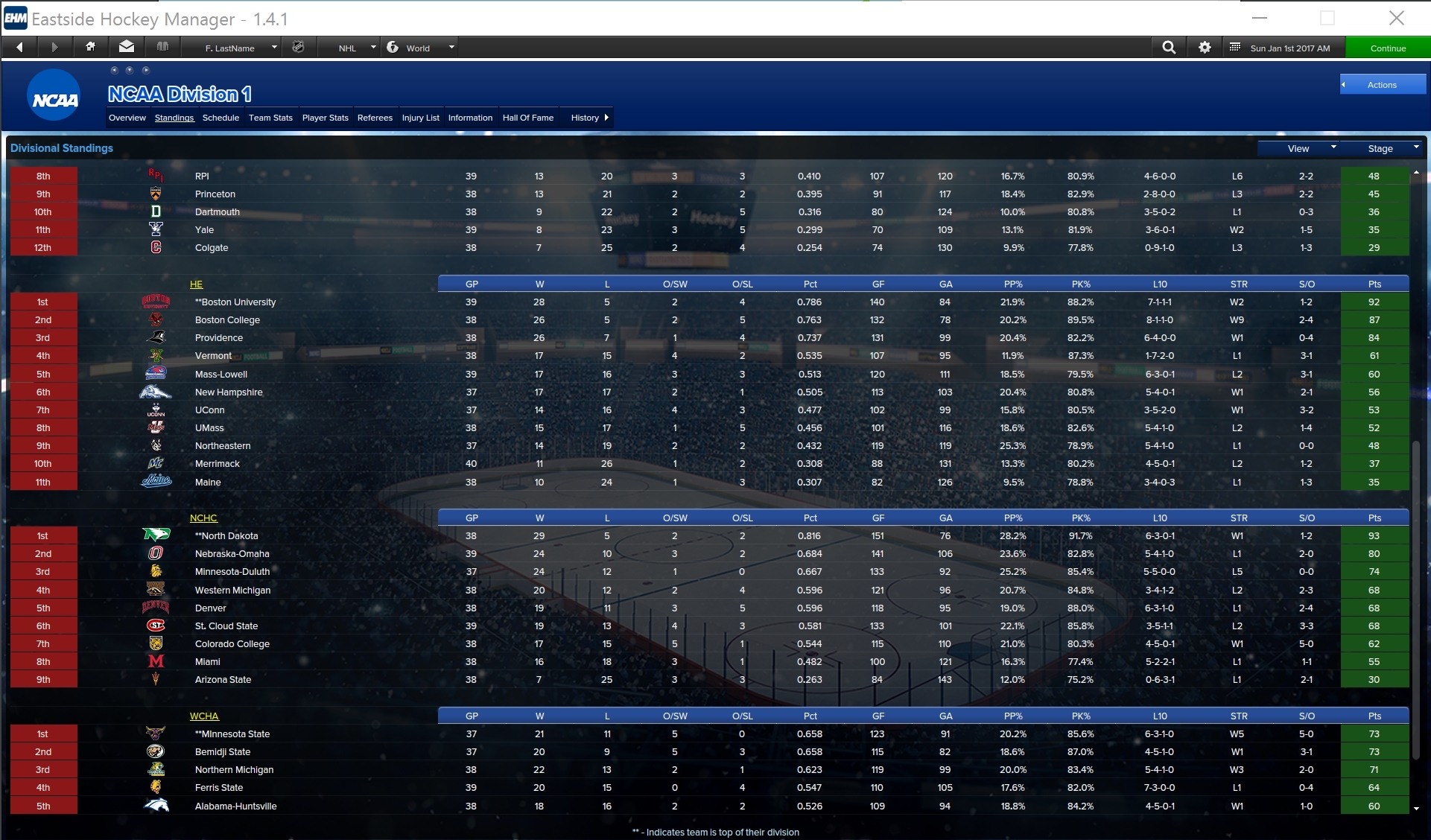NCAA - League settings & feedback
Posted: Sat Feb 11, 2017 3:24 pm
Hi all, thought this might be worthy of its own topic - if not go ahead and fold into the editing structures thread.
I've done a lot of work in the past week and have a working NCAA (Division 1) model up to speed. In fact - I'm working on two different paths and I hope to have the second model up to speed as well this weekend...and we can have some debate as to the better model to use going forward.
MODEL 1 (the working one you will see below): The Conferences as Leagues Model:
PROS
- You can customize each league rule setting which is useful as not all conferences have the same rules.
- It emphasizes conference play. Well, you can only have conference play in this model (until the Frozen Four). Since automatic bids to the real NCAA tournament are based on conference champions, I do feel conference play is more important than non-conference games.
- Nice little perks like customized graphics for each conference (since each one is a league), news items for winning teams from each conference, etc. For history, you can look up conference winners and runners-up in each conference but then also look up the NCAA title winners for that competition.
- The six conference champions move on to the NCAA Division 1 Ice Hockey Championships which turns into a Frozen Four which then turns into the NCAA title game. It's a similar setup to the CHL Memorial Cup as it is its own league that draws conference winners from the 6 conferences.
- Flexibility at setup to choose leagues individually...or just choose the NCAA Championships and it will automatically seelcted the six conferences because they are linked to it.
CONS
- No non-conference games. These cannot be scheduled as far as I can tell. So all regular season games are 100% only against teams in your conference (league).
- Stats are conference based...you can cycle through the conferences to see all the statistical leaders but there is no way to have a composite NCAA stats board.
- The NCAA Championship works great and gives you the feel of the Frozen Four but obviously is not accurate to real life in setup. In real life, it's a 16 game, partially-seeded playoff tournament. From what I can tell, I can only bring each conference winner over to this competition so that is 6 teams. I can get 7 by having a random linked league team host (like the Memorial Cup) but that really accomplishes nothing except add an undeserving team. So the NCAA Championship is setup to a single, round robin format for stage 1 (like Memorial Cup) but then differs from the Memorial Cup in that the 4 highest seeds are then simply moved on to the overall national playoff semi-final (Frozen Four).
Things I have done a bit differently for this setup:
- NCAA teams play between 29 games (Ivy Schools) and 38 games per year total, including non-conference games. Conferences play between 22-28 conference games. This structure allows me to vary games played by conference and not have it matter because to make the NCAA Championships you only have to win your conference. However, for the sake of statistical comparisons, I have setup each conference (league) to play 34 games. This makes college stats comparisons between the conferences in this setup more relevant. Each team plays 17 home and 17 road conference games.
- I have structured games to fall completely on Friday and Saturdays where 90% of real life college games are played, with the appropriate breaks around Thanksgiving and December/January. Almost all college games are actually played as two game sets to reduce travel. I have not yet done this - and probably won't. You still get the feel and length and rhythm of the real college season.
- Rules are not yet fine-tuned to each particular league. Haven't added training camp either which I mean to do for each conference.
- Conference Alignment: Notre Dame has been moved to the Big Ten where they will start play next year (from Hockey East) while Arizona State still doesn't have a conference but have been moved to the NCHC, where they applied (but were rejected) last summer. I still think they could end up there though. If something more firm comes up, I will modify them accordingly.
MODEL 2 (work in progress): The Conferences as Divisions Model
PROS
- This is where the entire structure is one league, with conferences as divisions and the NCAA tournament as a 16-team playoff.
- Allows for non-conference games. I'm working on a schedule matrix that will still be heavy on conference games like real life but will include a lot of non-conference games at the beginning of the year. This will make for some more interesting matchups but you'll still get a higher dose of conference games.
- Allows for standings and stats to be sorted by overall NCAA - which gives you a way to compare teams/players at once. The league screen will essentially show the overall rankings of all 60 teams and then if you go to standings by division, you can see the conference (division) standings.
- The whole thing is a bit streamlined; you would only need to click one league at the setup screen to activate the entire model.
- Sixteen team playoff more accurately reflects the structure of the actual NCAA Championships, with the semi-final round being the Frozen Four.
CONS
- You lose the graphical interface of each conference...it's simply the "NCAA Division 1" and you get the NCAA logo and all the teams but not the customized feel of each conference as a league. So in the NHL draft screen, you also don't see what conference the player is from, you just get the team and a little NCAA logo.
- You lose the ability to track conference champions; because in this setup, they are merely division winners.
- You lose the ability for custom rules and schedules for each conference. While I chose to have all teams play 34 games in Model 1 - in this model, you have to have all teams play the same number of games because otherwise entering teams into the playoffs (NCAA Championships) by points with different amount of games played makes no sense.
- Sixty teams at once can be a little overwhelming in terms of size as you sort through standings and statistics.
Issues with BOTH types of models:
- Ok - this is a BIG one I have not yet figured out. I can't figure out how to actually sign players (recruits). I have the leagues/conferences set as IIHF (no transfer) so that teams don't trade (there is no trading in the NCAA). The computer will still add recruits to NCAA teams - either by way of preset transfers in the editors or kind of randomly like it always has based on the reputation of the team and recruit (from the likes of the USHL, High School and Canadian Jr A leagues). But you can't control it as of now.
- If you have EHM add fake players, those initial fake players are not given real 4 year contracts. It will add a bunch of players, some who are 18 or 19 but then just randomly leave after the first year. This issue does not seem to affect fake players later on who are actually recruited/signed by NCAA teams - those players will continue to behave like real recruits with 4 years of eligibility...it's only the first batch of fake players if you add them to start to fill out team rosters.
- Speaking of team rosters - in my DB, I have made sure every single team (60 in total) has at least around 12 real players and most have more like 18-20. I haven't checked the TBL set, those may be even beefier so I suggest not using fake players at the start if you really want the NCAA to appear more accurately unless your DB has only like a couple players per team.
Screenshots to follow...
I've done a lot of work in the past week and have a working NCAA (Division 1) model up to speed. In fact - I'm working on two different paths and I hope to have the second model up to speed as well this weekend...and we can have some debate as to the better model to use going forward.
MODEL 1 (the working one you will see below): The Conferences as Leagues Model:
PROS
- You can customize each league rule setting which is useful as not all conferences have the same rules.
- It emphasizes conference play. Well, you can only have conference play in this model (until the Frozen Four). Since automatic bids to the real NCAA tournament are based on conference champions, I do feel conference play is more important than non-conference games.
- Nice little perks like customized graphics for each conference (since each one is a league), news items for winning teams from each conference, etc. For history, you can look up conference winners and runners-up in each conference but then also look up the NCAA title winners for that competition.
- The six conference champions move on to the NCAA Division 1 Ice Hockey Championships which turns into a Frozen Four which then turns into the NCAA title game. It's a similar setup to the CHL Memorial Cup as it is its own league that draws conference winners from the 6 conferences.
- Flexibility at setup to choose leagues individually...or just choose the NCAA Championships and it will automatically seelcted the six conferences because they are linked to it.
CONS
- No non-conference games. These cannot be scheduled as far as I can tell. So all regular season games are 100% only against teams in your conference (league).
- Stats are conference based...you can cycle through the conferences to see all the statistical leaders but there is no way to have a composite NCAA stats board.
- The NCAA Championship works great and gives you the feel of the Frozen Four but obviously is not accurate to real life in setup. In real life, it's a 16 game, partially-seeded playoff tournament. From what I can tell, I can only bring each conference winner over to this competition so that is 6 teams. I can get 7 by having a random linked league team host (like the Memorial Cup) but that really accomplishes nothing except add an undeserving team. So the NCAA Championship is setup to a single, round robin format for stage 1 (like Memorial Cup) but then differs from the Memorial Cup in that the 4 highest seeds are then simply moved on to the overall national playoff semi-final (Frozen Four).
Things I have done a bit differently for this setup:
- NCAA teams play between 29 games (Ivy Schools) and 38 games per year total, including non-conference games. Conferences play between 22-28 conference games. This structure allows me to vary games played by conference and not have it matter because to make the NCAA Championships you only have to win your conference. However, for the sake of statistical comparisons, I have setup each conference (league) to play 34 games. This makes college stats comparisons between the conferences in this setup more relevant. Each team plays 17 home and 17 road conference games.
- I have structured games to fall completely on Friday and Saturdays where 90% of real life college games are played, with the appropriate breaks around Thanksgiving and December/January. Almost all college games are actually played as two game sets to reduce travel. I have not yet done this - and probably won't. You still get the feel and length and rhythm of the real college season.
- Rules are not yet fine-tuned to each particular league. Haven't added training camp either which I mean to do for each conference.
- Conference Alignment: Notre Dame has been moved to the Big Ten where they will start play next year (from Hockey East) while Arizona State still doesn't have a conference but have been moved to the NCHC, where they applied (but were rejected) last summer. I still think they could end up there though. If something more firm comes up, I will modify them accordingly.
MODEL 2 (work in progress): The Conferences as Divisions Model
PROS
- This is where the entire structure is one league, with conferences as divisions and the NCAA tournament as a 16-team playoff.
- Allows for non-conference games. I'm working on a schedule matrix that will still be heavy on conference games like real life but will include a lot of non-conference games at the beginning of the year. This will make for some more interesting matchups but you'll still get a higher dose of conference games.
- Allows for standings and stats to be sorted by overall NCAA - which gives you a way to compare teams/players at once. The league screen will essentially show the overall rankings of all 60 teams and then if you go to standings by division, you can see the conference (division) standings.
- The whole thing is a bit streamlined; you would only need to click one league at the setup screen to activate the entire model.
- Sixteen team playoff more accurately reflects the structure of the actual NCAA Championships, with the semi-final round being the Frozen Four.
CONS
- You lose the graphical interface of each conference...it's simply the "NCAA Division 1" and you get the NCAA logo and all the teams but not the customized feel of each conference as a league. So in the NHL draft screen, you also don't see what conference the player is from, you just get the team and a little NCAA logo.
- You lose the ability to track conference champions; because in this setup, they are merely division winners.
- You lose the ability for custom rules and schedules for each conference. While I chose to have all teams play 34 games in Model 1 - in this model, you have to have all teams play the same number of games because otherwise entering teams into the playoffs (NCAA Championships) by points with different amount of games played makes no sense.
- Sixty teams at once can be a little overwhelming in terms of size as you sort through standings and statistics.
Issues with BOTH types of models:
- Ok - this is a BIG one I have not yet figured out. I can't figure out how to actually sign players (recruits). I have the leagues/conferences set as IIHF (no transfer) so that teams don't trade (there is no trading in the NCAA). The computer will still add recruits to NCAA teams - either by way of preset transfers in the editors or kind of randomly like it always has based on the reputation of the team and recruit (from the likes of the USHL, High School and Canadian Jr A leagues). But you can't control it as of now.
- If you have EHM add fake players, those initial fake players are not given real 4 year contracts. It will add a bunch of players, some who are 18 or 19 but then just randomly leave after the first year. This issue does not seem to affect fake players later on who are actually recruited/signed by NCAA teams - those players will continue to behave like real recruits with 4 years of eligibility...it's only the first batch of fake players if you add them to start to fill out team rosters.
- Speaking of team rosters - in my DB, I have made sure every single team (60 in total) has at least around 12 real players and most have more like 18-20. I haven't checked the TBL set, those may be even beefier so I suggest not using fake players at the start if you really want the NCAA to appear more accurately unless your DB has only like a couple players per team.
Screenshots to follow...
